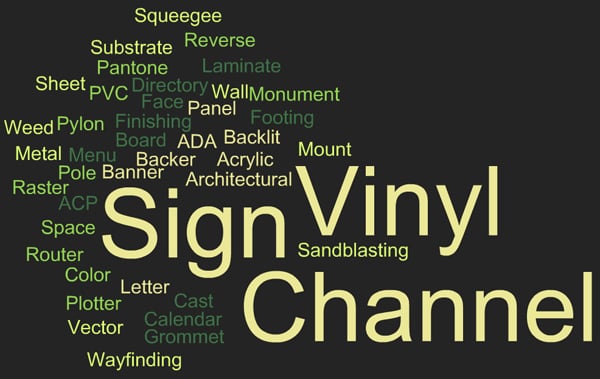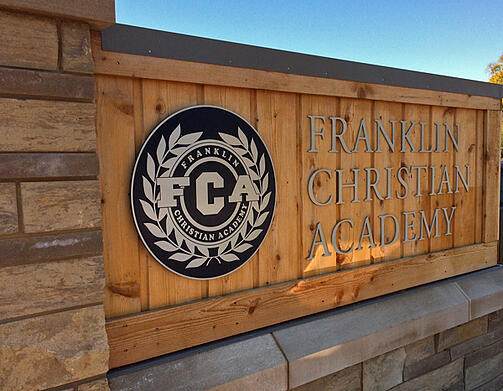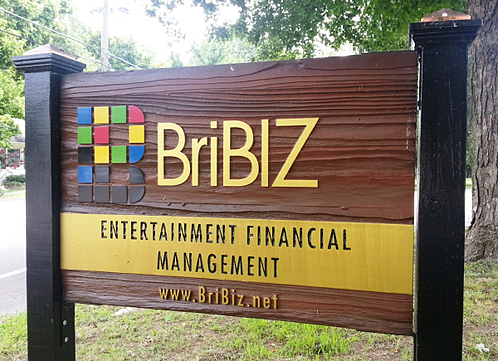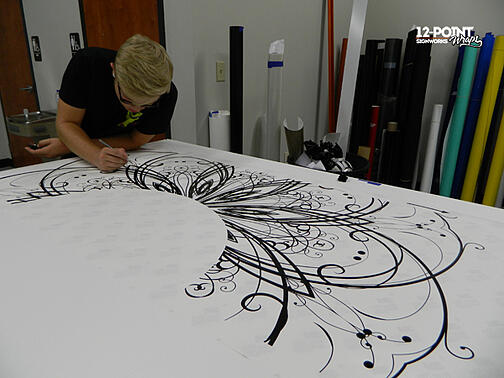What are we talking about? You may be thinking that if you are new to the signage industry or have had a recent conversation with a sign maker. The sign making business has its own set of terms and acronyms that are used all the time, but how do you even begin to learn all of them?

To make it easier on you (and us), I've compiled a list of some of the more common terms and their meanings. Hopefully, this will help you feel more comfortable when speaking signage language. (Insert heavy laughter here!)
Aluminum Composite Panel (ACP): A type of flat panel used in signage that consists of two thin aluminum sheets bonded to a non-aluminum core.
Acrylic: An extruded or cast rigid plastic characterized by its clarity and colorability. It also can refer to a type of paint with an acrylic resin base.
ADA (Americans with Disabilities Act): So you may already know what that acronym means, but did you know that there are sections in the Act that apply to signage? The ADA addresses the needs of physically impaired citizens. The two sections that cover signage include Title II (government and public-sector activities) and Title III (private sector). You can read up on the rules at the ADA website.
Architectural Sign: A sign type, often part of a system of signs, associated with the architecture of a building or building complex, giving information about specific locations within, wayfinding and other features.
Backer Panel: A flat structure mounted behind sign letters that can be custom designed and manufactured into different shapes and colors.
Backlit Sign: A sign consisting of a cabinet containing a light source surrounded by one or more translucent faces, illuminated for visibility.
Banner: A sign usually made of fabric, vinyl or other non-rigid material with no enclosing framework. The material may be painted, screen printed, digitally printed or decorated with vinyl.
Banner Finishing: Various applications used to complete a banner, including seaming, hemming, pockets, reinforcement, clear tape, grommets, etc.
Bleed: The portion of the job that extends beyond the area of the finished print and will be trimmed off.
Calendar Vinyl: Vinyl sheeting squeezed between a series of heated rollers to achieve a small enough thickness for cutting with a knife plotter. Calendar film is generally thicker and less expensive than cast vinyl.
Cast Vinyl: A type of vinyl film formed by spreading a molten plastic mixture (or organosol) on a carrier sheet in a thin layer and then baking at high temperatures to remove solvents and fuse the remaining material into a film. Cast film is usually thinner, more pliable and more expensive than calendar vinyl. Vehicle wraps should always be installed with cast vinyl!
Channel Letter: The outline of a letter that has extended sidewalls (or returns) to create depth. The letters are typically made from sheet metal (mainly aluminum) or plastic and are usually fitted with lighting components.
Directory Sign: An on-premise sign that identifies the names and locations of tenants in a multi-tenant building or group of buildings.
 This is a sample of an exterior dimensional logo sign we fabricated as a directory sign.
This is a sample of an exterior dimensional logo sign we fabricated as a directory sign.
Face: The decorated surface of a sign. The area on which the copy and art is placed.
Footing: The (typically) concrete supporting base of a structure, as for a pylon or a monument sign.
Grommet: A reinforced metal eyelet found in banners for the purpose of receiving cords or other fasteners used for hanging.
Laminate: The process by which different materials are layered and then bonded together using adhesion.
Menu Board: A changeable, point-of-purchase advertising display that allows the retailer to list products and prices.
Monument Sign: A free-standing sign sitting directly on the ground or mounted on a low base.
 We installed cut aluminum letters and a laser etched plaque to the wooden face of the monument sign for Franklin Christian Academy.
We installed cut aluminum letters and a laser etched plaque to the wooden face of the monument sign for Franklin Christian Academy.
Negative Space (a.k.a. white space): The area around and within the art and copy.
Pantone Matching System (PMS): A largely standardized color reproduction system where colors are described by an allocated number. Most PMS colors are simulated with 13 base pigments - plus black - mixed in specified amounts.
Plotter: A device that interprets information sent from a computer and moves a tool head to a series of coordinates based on the device's X and Y axes. Sign makers (like us!) use a plotter equipped with a knife to cut vinyl with the X and Y coordinates, forming an outline that can be weeded and installed on a surface.
Pole Sign: A free-standing sign, usually double faced, mounted on a round pole, square tube or other fabricated member without any type of secondary support.
Positive Space: In design, the copy and art visible on a sign face. The opposite of negative space.
Process Color: The three primary colors of printing - cyan (blue), magenta (red), and yellow plus black (or key). When printed as halftones in that order, they create a full range of natural colors. This is also know as four-color process or CMYK color model.
Push-Through: A letter or graphic which is cut out and then pushed through a corresponding space that has been removed from the sign substrate.
PVC (Polyvinyl Chloride): The most common form of plastic in use today. PVC is extruded or cast as sheets, tubing or films. PVC films are commonly referred to as vinyl.
Pylon: Any free-standing sign that is not a pole or ground sign.
Raster Image: An image created by a collection of pixels, or points of color arranged in a rectangular grid.
Regulatory Signs: Signs installed by various government bodies to acquaint the public with traffic laws and other regulations.
Reverse Channel Letter: A channel letter that has a face and sides but no back. It is pegged out from a background surface. When the inside of the channel is lit, it produces a halo effect around the letter.
Router: In sign-making, a machine tool that mills out the surface of metal or wood.
Sandblasting: A pressurized stream of sand or synthetic particles used to remove material from a substrate, such as glass or wood.
 We get a lot of inquiries about this sandblasted wood sign we fabricated for BriBiz.
We get a lot of inquiries about this sandblasted wood sign we fabricated for BriBiz.
The raised, painted logo and lettering give it a one-of-a-kind look!
Second-Surface: Refers to a sign made of a clear substrate, such as glass or acrylic, where the art is done in reverse on what will be an interior face of the sign. This provides extra protection.
Sheet Metal: Aluminum or steel in sheets or plates used as a sign substrate.
Squeegee: Yes, this is a technical term for us! In sign making, a hard plastic or nylon blade used to apply pressure to increase surface adhesion between cut vinyl and the transfer tape or between the vinyl and sign/vehicle face.
Substrate: The material out of which a sign face is made. Wood, metal and acrylic are all sign substrates.
Tactile Sign: A sign, or area within a larger sign, that conveys its message through raised or engraved art, making it accessible to the visually impaired.
Temporary Sign: Any sign that is not intended to be permanently installed, such as banners and construction site signs. Often, local and area sign codes seek to limit the length of time that a temporary sign can be in place. (Always check your local codes before starting a project!)
Vector Image: A computer image that defines graphic pixels through the use of mathematical descriptions of paths and files. We request all art in vector format!
Wall Mount: A single-face sign mounted on a wall.
Wayfinding: A system of signage and graphics which is designed to give direction to a given destination.
Weed: In cut vinyl sign making, the process of peeling the extra vinyl away from the plotter cut, leaving only the sections representing the final image. Pulling the extra vinyl away in one quick stroke is known as rip-weeding.
 Talk about detail! It took some time for our talented designer, Zane,
Talk about detail! It took some time for our talented designer, Zane,
to hand weed the graphics that we installed on a Mini Cooper.
(Click on the photo to see the finished product!)
Looking for signage or a vehicle wrap for your business? Contact us today to get started. With your new vocabulary, you are ready to talk the talk!



Leave a Reply